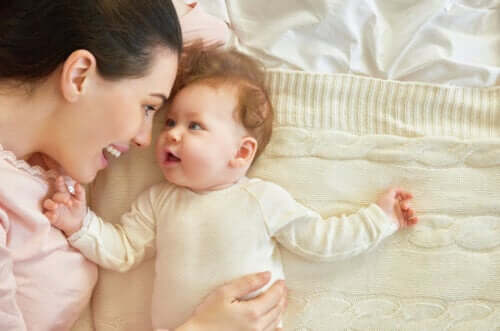How to Help Your Child Transition from a Crib to a Bed


Written and verified by the child educator Pedro González Núñez
It’s not always easy for children to make the transition from a crib to a bed. Only children that have already learned and have enough emotional maturity tend to do so without any problems.
What’s more, the possible risks that this transition involves for babies is another factor that parents need to consider. Before even attempting this change, families must have already established a proper bedtime routine. Little ones need to know that they’re safe and nothing is going to happen to them.
Therefore, it’s important for children’s sleeping habits to be correct. If you follow the same routine every night, then all of you know that nothing will happen, and your little one will catch on to sleeping in a bed quickly.
The transition from a crib to a bed
If parents aren’t careful about how they take on this process, it can produce unnecessary frustration in their little ones.
Author and child psychologist Noelia Esteban de la Casa is a specialist in this type of situation. According to her, parents should wait until their little ones are at least 18 months old before beginning the transition. And both parents and children will need to demonstrate sufficient emotional maturity in order to make the transition securely.

Then, it’s also important for little ones to participate in the process. You can allude to your child’s age, responsibility, and ability to take on and overcome challenges. For example, tell your child he or she is older now and ready to sleep in his or her own bed.
It’s also important not to offer too many explanations in order for the process to be as natural as possible. However, you should explain and respond to any doubts that come up in a concise and coherent manner.
Stimulating the process
The process of going from a crib to a bed requires stimulation. And in that sense, there’s nothing better than play to make the process both natural and fun.
By the time children are 12 months old, they already know how to mimic patterns from real life in their play. For example, they know how to pretend to eat with a toy spoon.
You can take advantage of this fact to make it easier for your little one to get used to sleeping in a bed in the future. That’s because, between the ages of 18 and 24 months, children start to initiate this type of play with their dolls. Therefore, you can have them put their dolls and stuffed animals to bed, thereby learning and accepting this new situation through play.
It’s crucial for parents to act as role models. In other words, you can set an example by putting the dolls to sleep yourself as if they were your children. You can tell them stories, sing them songs, and take advantage of anything you can think of in order for your little one to fall asleep along with his or her toys.
How to leave your child feeling safe and relaxed
The transition from a crib to a bed requires children to feel safe and relaxed. Children should feel good about the change and not suffer. In general, children are able to make the transition peacefully, but it may become complicated in certain cases. To make things easier, take note of the ideas that expert Noelia Esteban has to offer:

- Talk to your child a lot. Even though it seems like little ones don’t understand, it’s good for them to get used to hearing us from the time they’re young.
- When it comes to explaining something to babies, you should get down on their level. In other words, squat down and look them in the eyes.
- Comfort your children’s tears and don’t leave them alone. They need to associate their bed with peace and calm.
- If little ones have a tantrum, you should first calm them down. Once they’re calm, talk to them slowly. Remember to be patient, as this process may take some time.
- Be sure to stick to a routine. A story, a snuggle, some time to talk…
Later, if your child wakes up, which is normal, here are some guidelines that you can use to rationalize the process and calm your child:
- Check on children without turning on the light. Sit down and lie down with them so that they can relax before falling back to sleep.
- Tend to their tears in order to offer security.
- If they’ve had a nightmare, lie down so that they can feel you nearby. Allow them to calm down and don’t wake them up.
Each child is unique, so the transition from a crib to a bed will be different in every case. Remember to be patient and give your child plenty of affection, understanding, and closeness. With your help, your child will be able to sleep in his or her bed when ready. If you’re really struggling, don’t hesitate to consult a specialist.
It’s not always easy for children to make the transition from a crib to a bed. Only children that have already learned and have enough emotional maturity tend to do so without any problems.
What’s more, the possible risks that this transition involves for babies is another factor that parents need to consider. Before even attempting this change, families must have already established a proper bedtime routine. Little ones need to know that they’re safe and nothing is going to happen to them.
Therefore, it’s important for children’s sleeping habits to be correct. If you follow the same routine every night, then all of you know that nothing will happen, and your little one will catch on to sleeping in a bed quickly.
The transition from a crib to a bed
If parents aren’t careful about how they take on this process, it can produce unnecessary frustration in their little ones.
Author and child psychologist Noelia Esteban de la Casa is a specialist in this type of situation. According to her, parents should wait until their little ones are at least 18 months old before beginning the transition. And both parents and children will need to demonstrate sufficient emotional maturity in order to make the transition securely.

Then, it’s also important for little ones to participate in the process. You can allude to your child’s age, responsibility, and ability to take on and overcome challenges. For example, tell your child he or she is older now and ready to sleep in his or her own bed.
It’s also important not to offer too many explanations in order for the process to be as natural as possible. However, you should explain and respond to any doubts that come up in a concise and coherent manner.
Stimulating the process
The process of going from a crib to a bed requires stimulation. And in that sense, there’s nothing better than play to make the process both natural and fun.
By the time children are 12 months old, they already know how to mimic patterns from real life in their play. For example, they know how to pretend to eat with a toy spoon.
You can take advantage of this fact to make it easier for your little one to get used to sleeping in a bed in the future. That’s because, between the ages of 18 and 24 months, children start to initiate this type of play with their dolls. Therefore, you can have them put their dolls and stuffed animals to bed, thereby learning and accepting this new situation through play.
It’s crucial for parents to act as role models. In other words, you can set an example by putting the dolls to sleep yourself as if they were your children. You can tell them stories, sing them songs, and take advantage of anything you can think of in order for your little one to fall asleep along with his or her toys.
How to leave your child feeling safe and relaxed
The transition from a crib to a bed requires children to feel safe and relaxed. Children should feel good about the change and not suffer. In general, children are able to make the transition peacefully, but it may become complicated in certain cases. To make things easier, take note of the ideas that expert Noelia Esteban has to offer:

- Talk to your child a lot. Even though it seems like little ones don’t understand, it’s good for them to get used to hearing us from the time they’re young.
- When it comes to explaining something to babies, you should get down on their level. In other words, squat down and look them in the eyes.
- Comfort your children’s tears and don’t leave them alone. They need to associate their bed with peace and calm.
- If little ones have a tantrum, you should first calm them down. Once they’re calm, talk to them slowly. Remember to be patient, as this process may take some time.
- Be sure to stick to a routine. A story, a snuggle, some time to talk…
Later, if your child wakes up, which is normal, here are some guidelines that you can use to rationalize the process and calm your child:
- Check on children without turning on the light. Sit down and lie down with them so that they can relax before falling back to sleep.
- Tend to their tears in order to offer security.
- If they’ve had a nightmare, lie down so that they can feel you nearby. Allow them to calm down and don’t wake them up.
Each child is unique, so the transition from a crib to a bed will be different in every case. Remember to be patient and give your child plenty of affection, understanding, and closeness. With your help, your child will be able to sleep in his or her bed when ready. If you’re really struggling, don’t hesitate to consult a specialist.
This text is provided for informational purposes only and does not replace consultation with a professional. If in doubt, consult your specialist.








